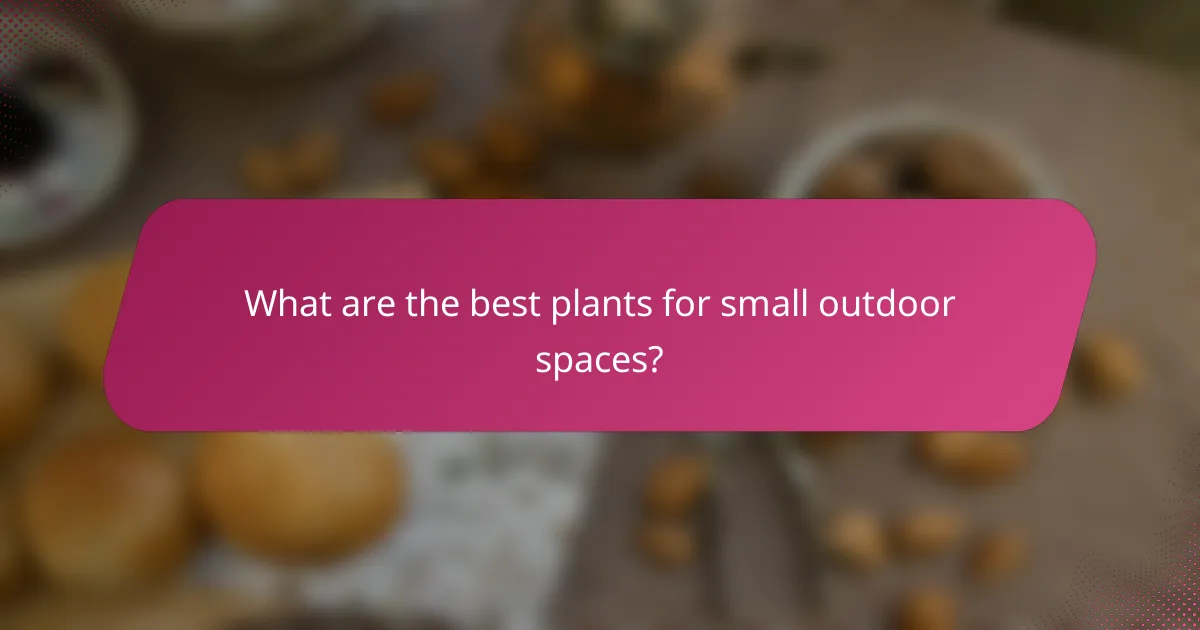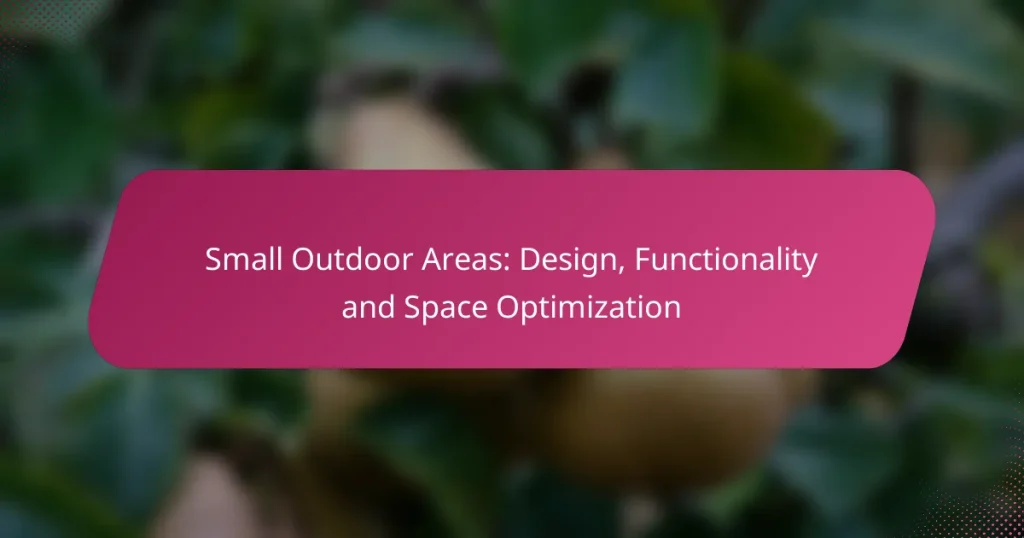Designing small outdoor areas in urban environments presents unique challenges and opportunities for creativity. By focusing on efficient space utilization and incorporating elements that enhance both functionality and aesthetics, you can create an inviting atmosphere. Selecting the right plants and versatile furniture, along with smart storage solutions, will help you maximize the potential of your limited space.

How to design small outdoor areas in urban settings?
Designing small outdoor areas in urban settings requires maximizing functionality while creating an inviting atmosphere. Focus on efficient use of space, incorporating elements that enhance both aesthetics and usability.
Vertical gardening techniques
Vertical gardening techniques are essential for small outdoor areas, allowing you to grow plants without taking up valuable ground space. Options include wall-mounted planters, trellises, and vertical garden systems that can be installed on fences or walls.
Consider using a mix of herbs, flowers, and climbing plants to create a lush, green environment. Ensure adequate sunlight and water access for your vertical garden to thrive, and choose lightweight materials to avoid structural issues.
Space-saving furniture options
Space-saving furniture options are crucial for optimizing small outdoor areas. Look for foldable tables and chairs, stackable seating, or benches with built-in storage to keep the space functional and uncluttered.
When selecting furniture, prioritize materials that withstand outdoor conditions, such as weather-resistant wood, metal, or synthetic materials. Aim for a cohesive design that complements your overall aesthetic while ensuring comfort and usability.
Use of natural materials
Incorporating natural materials enhances the beauty and sustainability of small outdoor areas. Use stone, wood, or bamboo for pathways, seating, and planters to create a harmonious connection with nature.
Natural materials not only provide a rustic charm but also blend well with greenery. Ensure that any wood used is treated for outdoor durability, and consider local sourcing to reduce environmental impact.
Incorporating water features
Incorporating water features can add tranquility and visual interest to small outdoor spaces. Options like small fountains, ponds, or even wall-mounted water installations can create a soothing atmosphere without requiring extensive space.
Choose a water feature that fits your style and maintenance preferences. Ensure proper installation to avoid leaks and consider energy-efficient pumps to minimize operational costs.
Lighting solutions for ambiance
Lighting solutions are vital for creating ambiance in small outdoor areas, allowing you to enjoy the space after dark. Use a combination of string lights, lanterns, and solar-powered fixtures to enhance the atmosphere while being energy-efficient.
Position lights strategically to highlight key features like plants or seating areas. Opt for warm-toned bulbs to create a cozy feel, and consider dimmable options for flexibility in mood setting.

What are the best plants for small outdoor spaces?
The best plants for small outdoor spaces are those that maximize visual appeal while requiring minimal maintenance. Consider factors such as size, growth habits, and local climate when selecting plants to ensure they thrive in your limited area.
Native plants for low maintenance
Native plants are ideal for small outdoor spaces because they are adapted to the local environment and typically require less water and care. Examples include coneflowers, black-eyed Susans, and various grasses that thrive in your region.
When choosing native plants, consider their growth patterns and mature sizes to avoid overcrowding. Grouping plants with similar water and sunlight needs can further simplify maintenance.
Container gardening varieties
Container gardening allows for flexibility in small outdoor areas, enabling you to rearrange plants as needed. Suitable varieties include herbs like basil and rosemary, as well as flowering plants such as petunias and geraniums.
When selecting containers, ensure they have proper drainage and are large enough to accommodate the plant’s root system. Use high-quality potting soil to promote healthy growth and consider using self-watering containers to reduce maintenance.
Perennials for year-round interest
Perennials are excellent for small outdoor spaces because they return each year, providing ongoing beauty with minimal effort. Consider varieties like daylilies, hostas, and sedums, which offer diverse colors and textures.
To maintain year-round interest, select perennials that bloom at different times throughout the growing season. This strategy ensures that your space remains vibrant and engaging, even in the off-season, when foliage can still provide visual appeal.

How to optimize functionality in small outdoor areas?
To optimize functionality in small outdoor areas, focus on maximizing usable space while ensuring comfort and aesthetics. This involves selecting versatile furniture, creating distinct zones for different activities, and incorporating smart storage solutions.
Multi-functional furniture
Multi-functional furniture is essential in small outdoor areas as it serves more than one purpose. For example, a bench that doubles as a storage box or a table that can be folded away when not in use can significantly enhance space efficiency.
When choosing multi-functional pieces, consider materials that withstand outdoor conditions, such as weather-resistant wood or metal. Look for items that can easily transition between uses, like ottomans that can serve as extra seating or side tables.
Creating defined zones
Creating defined zones helps organize a small outdoor area and makes it feel larger. Use furniture arrangement, rugs, or planters to delineate spaces for dining, lounging, or gardening.
For instance, place a small table and chairs in one corner for dining, while a couple of lounge chairs can create a cozy reading nook. This separation allows for distinct activities without cluttering the area.
Incorporating storage solutions
Incorporating storage solutions is crucial for maintaining a tidy and functional outdoor space. Utilize vertical storage options, such as wall-mounted shelves or hanging planters, to free up floor space.
Consider built-in seating with hidden compartments or decorative storage boxes that blend with your outdoor decor. This approach keeps essential items accessible while minimizing visual clutter, ensuring your small area remains inviting and organized.

What are the local regulations for outdoor design?
Local regulations for outdoor design vary significantly by location and often include zoning laws, building codes, and permit requirements. Understanding these regulations is crucial for ensuring that your outdoor space is both functional and compliant.
Permits for landscaping in Los Angeles
In Los Angeles, landscaping projects may require permits depending on the scope and nature of the work. For instance, significant alterations to grading, drainage, or the installation of hardscapes typically necessitate a permit.
Homeowners should check with the Los Angeles Department of Building and Safety to determine specific requirements. It’s advisable to submit plans for review to avoid potential fines or mandated removal of unpermitted work.
Building codes for outdoor structures
Building codes in Los Angeles dictate standards for outdoor structures such as decks, patios, and fences. These codes ensure safety and structural integrity, often specifying height limits, materials, and setback requirements from property lines.
Before constructing any outdoor structure, consult the local building department to obtain necessary permits and ensure compliance with all relevant codes. Non-compliance can lead to costly modifications or legal issues.

How to enhance privacy in small outdoor spaces?
Enhancing privacy in small outdoor spaces can be achieved through strategic design elements that create barriers and visual separation. Utilizing structures and plants effectively can help you enjoy your outdoor area without feeling exposed to neighbors or passersby.
Use of trellises and screens
Trellises and privacy screens are excellent options for creating visual barriers in small outdoor areas. They can be placed strategically to block sightlines while allowing light and air to flow through. Consider using materials like wood, metal, or even fabric to match your outdoor aesthetic.
When selecting trellises or screens, think about their height and placement. A taller trellis can provide more privacy, while a lower one might work better in a space where you want to maintain an open feel. You can also enhance their effectiveness by climbing plants, such as vines, which will grow over time and add greenery.
Planting hedges for natural barriers
Planting hedges is a natural and effective way to enhance privacy in small outdoor spaces. Dense shrubs can act as a living fence, providing a green barrier that not only blocks views but also absorbs noise. Choose fast-growing varieties to achieve privacy more quickly.
Consider the height and width of the hedges when planning your layout. For small spaces, opt for compact varieties that won’t overwhelm the area. Regular maintenance, such as trimming and shaping, will ensure that your hedges remain an effective privacy solution while enhancing the overall look of your outdoor space.

What are the trends in small outdoor area design?
Current trends in small outdoor area design focus on maximizing functionality while enhancing aesthetic appeal. Homeowners increasingly prioritize multi-use spaces that incorporate sustainable practices, allowing for enjoyment and environmental responsibility.
Sustainable landscaping practices
Sustainable landscaping practices aim to create outdoor spaces that are environmentally friendly and resource-efficient. This includes using native plants that require less water and maintenance, as well as incorporating rain gardens to manage stormwater runoff effectively.
When designing a small outdoor area, consider implementing permeable paving to reduce water runoff and improve drainage. Additionally, using organic mulch can help retain moisture in the soil while minimizing the need for chemical fertilizers.
To further enhance sustainability, think about incorporating features like compost bins or vertical gardens. These not only optimize space but also promote recycling and healthy plant growth, making your outdoor area both functional and eco-friendly.


